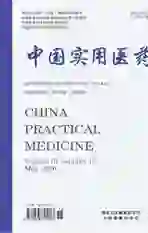呼吸机联合激素及丙种球蛋白治疗重症肺炎的效果研究
2020-07-01林宇斌温建立仲艾芳
林宇斌 温建立 仲艾芳



【摘要】 目的 了解重癥肺炎患者采用呼吸机联合激素及丙种球蛋白治疗的效果。方法 70例重症肺炎患者, 随机分为常规治疗组和联合治疗组, 每组35例。常规治疗组患者给予常规治疗, 联合治疗组患者给予呼吸机联合激素及丙种球蛋白治疗。比较两组患者治疗效果;咳嗽症状消失时间、血清炎症指标恢复正常时间、咳痰消失时间、肺部湿啰音消失时间;治疗前后血气分析指标、肺部炎症指标以及肺功能指标;呼吸机相关性肺炎发生情况。结果 联合治疗组患者的治疗总有效率为100.00%, 高于常规治疗组的77.14%, 差异具有统计学意义(P<0.05)。治疗后, 联合治疗组患者氧分压(PaO2)、二氧化碳分压(PaCO2)、肿瘤坏死因子-α(TNF-α)、超敏C反应蛋白(hs-CRP)、白细胞介素-6(IL-6)水平均优于常规治疗组, 差异具有统计学意义(P<0.05)。治疗后, 联合治疗组患者用力肺活量(FVC)、第1秒用力呼气容积(FEV1)、呼气峰值流速(PEF)均高于常规治疗组, 差异具有统计学意义(P<0.05)。联合治疗组咳嗽症状消失时间、血清炎症指标恢复正常时间、咳痰消失时间、肺部湿啰音消失时间分别为(8.24±1.45)、(9.11±1.21)、(8.24±1.41)、(10.21±2.21)d, 均短于常规治疗组的(10.34±1.67)、(11.45±1.67)、(10.78±1.89)、(12.78±2.78)d, 差异具有统计学意义(P<0.05)。联合治疗组患者呼吸机相关性肺炎发生率为2.86%(1/35), 低于常规治疗组的25.71%(9/35), 差异具有统计学意义(P<0.05)。结论 重症肺炎患者实施呼吸机联合激素及丙种球蛋白治疗效果确切, 可有效改善患者血气分析指标, 并提高肺功能, 控制肺部炎症, 缩短住院时间, 减少呼吸机相关性肺炎的发生。
【关键词】 重症肺炎;呼吸机;激素;丙种球蛋白;效果
DOI:10.14163/j.cnki.11-5547/r.2020.15.001
Study on the effect of ventilator combined with hormone and gamma globulin on severe pneumonia LIN Yu-bin, WEN Jian-li, ZHONG Ai-fang. Zunyi Medical University, Zunyi 563000, China
【Abstract】 Objective To understand the effect of ventilator combined with hormone and gamma globulin on severe pneumonia. Methods A total of 70 severe pneumonia patients were randomly divided into conventional treatment group and combined treatment group, with 35 cases in each group. Patients in the conventional treatment group received conventional treatment, while patients in the combined treatment group received ventilator combined with hormone and gamma globulin treatment. The therapeutic effect, disappearance time of cough, time for serum inflammation index to return to normal, disappearance time of expectoration and lung moistrale, blood gas analysis index, lung inflammation index and lung function index before and after treatment, and occurrence of ventilator associated pneumonia were compared between the two groups. Results The total effective rate of treatment of combined treatment group was 100.00%, which was higher than that of the conventional treatment group 77.14%, and the difference was statistically significant (P<0.05). After treatment, the levels of partial pressure of oxygen (PaO2), partial pressure of carbon dioxide (PaCO2), tumor necrosis factor-α(TNF-α), high sensitivity C-reactive protein (hs-CRP), interleukin-6 (IL-6) of the combined treatment group were better than those of the conventional treatment group, and the difference was statistically significant (P<0.05). After treatment, the forced vital capacity (FVC), forced expiratory volume (FEV1) in the first second, peak expiratory flow (PEF) of the combined treatment group were higher than those of the conventional treatment group, and the difference was statistically significant (P<0.05). The disappearance time of cough, time for serum inflammation index to return to normal, disappearance time of expectoration and lung moistrale of the combined treatment group were (8.24±1.45), (9.11±1.21), (8.24±1.41) and (10.21±2.21) d, which were shorter than those of the conventional treatment group (10.34±1.67), (11.45±1.67), (10.78±1.89) and (12.78±2.78) d, and the difference was statistically significant (P<0.05). The incidence of ventilator associated pneumonia of combined treatment group was 2.86%(1/35), which was lower than that of the conventional treatment group 25.71%(9/35), and the difference was statistically significant (P<0.05). Conclusion Ventilator combined with hormone and gamma globulin shows affirmative effect on severe pneumonia, which can effectively improve blood gas analysis index, improve lung function, control lung inflammation, shorten hospitalization time, and reduce the occurrence of ventilator-associated pneumonia.
本研究结果显示:治疗后, 联合治疗组患者的治疗总有效率高于常规治疗组, PaO2、PaCO2、TNF-α、hs-CRP、IL-6水平均优于常规治疗组, FVC、FEV1、PEF均高于常规治疗组, 咳嗽症状消失时间、血清炎症指标恢复正常时间、咳痰消失时间、肺部湿啰音消失时间均短于常规治疗组, 呼吸机相关性肺炎发生率低于常规治疗组, 差异具有统计学意义(P<0.05)。
综上所述, 重症肺炎患者实施呼吸机联合激素及丙种球蛋白治疗效果确切, 可有效改善患者血气分析指标, 并提高肺功能, 控制肺部炎症, 缩短住院时间, 减少呼吸机相关性肺炎的发生。
参考文献
[1] 李艳. 丙种球蛋白联合氨溴索佐治疗小儿重症肺炎疗效观察研究. 临床医药文献电子杂志, 2019, 6(42):39, 42.
[2] 蒋红侠, 王彦波, 金宝, 等. 经鼻持续气道正压通气联合丙种球蛋白对新生儿重症肺炎合并心力衰竭的疗效观察. 河北医药, 2019, 41(9):1345-1348.
[3] 刘敏. 丙种球蛋白静脉滴注辅助治疗小儿糖尿病合并重症肺炎的临床效果研究. 糖尿病新世界, 2019, 22(8):53-54.
[4] 薛飞, 汪受传. 糖皮质激素联合丙种球蛋白对小儿肺炎临床症状和炎症指标的影响. 中国中西医结合儿科学, 2018, 10(2):93-95.
[5] 王一鸣, 刘盼盼. 护理干预对丙种球蛋白静脉滴注佐治小儿重症肺炎的影响. 中国卫生统计, 2017, 34(6):975, 978.
[6] 李青. 丙种球蛋白联合甲基泼尼松龙治疗小儿急性重症支原体肺炎的临床效果. 中国当代医药, 2017, 24(27):55-57.
[7] 赵大兴. 新生儿重症肺炎静脉滴注丙种球蛋白疗效观察. 中国实用医刊2015(13):23-24.
[8] Welte T, Dellinger RP, Ebelt H, et al. Concept for a study design in patients with severe community-acquired pneumonia: A randomised controlled trial with a novel IGM-enriched immunoglobulin preparation-The CIGMA study. Respiratory medicine, 2015, 109(6):758-767.
[9] 张敏. 新生儿重症肺炎静脉滴注丙種球蛋白疗效观察. 世界最新医学信息文摘, 2016, 16(49):181.
[10] 侯萍萍, 李敬衡. 丙种球蛋白静脉滴注用于辅助治疗小儿重症肺炎的临床观察. 中国实用医药, 2016, 11(10):197-199.
[11] 潘国洪, 严军平. 不同剂量肾上腺皮质激素联合抗感染药物治疗儿科重症感染效果. 中国医院药学杂志, 2016, 36(8):666-669, 686.
[12] 许丹. 丙种球蛋白静脉滴注辅助治疗小儿重症肺炎的临床观察. 中国现代药物应用, 2016, 10(3):146-147.
[13] 李岩. 糖皮质激素联合丙种球蛋白治疗麻疹并发重症肺炎疗效观察. 中国现代药物应用, 2016, 10(3):165-166.
[14] 庞文静. 儿科重症肺炎74例临床治疗观察. 大家健康(学术版), 2015, 9(24):89.
[15] 刘明艳. 丙种球蛋白静脉滴注治疗重症肺炎的效果分析. 中国当代医药, 2015, 22(25):117-118, 121.
[收稿日期:2020-01-22]
